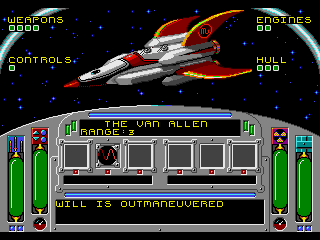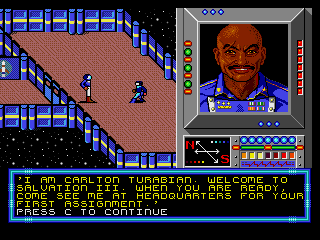30 years on, the story behind one of the Mega Drive's best RPGs
Buck, you're my kind of guy.
Mega Drive owners didn't often glance enviously at their Super Nintendo friends. After all, we had amazing platform games. We had fantastic shoot 'em ups. We had great arcade conversions. But there was one thing we didn't have: the sprawling RPGs of the Nintendo console, such as The Secret Of Mana, Final Fantasy and The Legend Of Zelda: A Link To The Past. True, there were Mega Drive RPGs, but none with quite the epic feel and expanse of their Nintendo peers. Then, for a brief period in the early 90s, it didn't matter. Because we had Buck Rogers: Countdown To Doomsday, a sci-fi RPG the likes of which never again appeared on the Sega console.
Countdown To Doomsday began life in 1990 as a PC, Commodore 64 and Amiga game. Released as part of its Gold Box series by Strategic Simulations Inc. (better known as SSI), the game was based on TSR's Buck Rogers XXVC table-top role-playing game, itself a blending together of the famous sci-fi character with the Dungeons & Dragons second edition ruleset. As was common at the time, Countdown presents a first-person exploration view combined with an isometric display for combat. Yet while the original has its fans, it's the Mega Drive conversion, released a year later, that is the most loved.
"I can still remember when I first laid my eyes on it," remembered my fellow Eurogamer contributor Jennifer Allen in her loving tribute to Countdown back in 2018. "On a shelf full of the usual mid-1990s suspects... Buck Rogers: Countdown to Doomsday stood out. A distinctive red box with some garish and heroic art, it couldn't help but stand out."
That box encased the famous Electronic Arts adapted Mega Drive cartridge after the company secured a contract to publish Countdown on the Sega console. Back in 1988, EA had signed a deal with SSI, making the developer an affiliate label and the publisher taking charge of distributing SSI's games while acquiring a 20% share of the company. SSI president at the time, Joel Billings, takes up the story. "Since we didn't have the money to get into console games, it was natural for us to license titles like our D&D games and Tony La Russa Baseball, and EA was a natural licensee due to their ownership in SSI."



Countdown To Doomsday's story runs back to the end of the 20th Century as nuclear war devastates the human race. Sent into space to destroy a new deadly missile system, pilot Buck Rogers succeeds in his mission but not before becoming frozen in space as war rages on Earth. Eventually, power shifts to the planet's corporations and by the time Rogers is discovered - 500 years later - it is dominated by the Russo-American Mercantile, aka RAM. Recently defrosted, the hero of yesteryear is now the hero of the future, joining up with the New Earth Organisation (NEO) to free the Earth and its colonies from the malevolent rule of RAM. Six bright and hopeful recruits are now thrust into the war, ready to take the fight to the colonies on Mars, Venus and beyond.
In charge of art on Countdown was SSI veteran Tom Wahl. Having joined the company in 1987, Wahl had already worked on several of its famed projects. "It was a magical time working with the SSI Special Projects Group," he says. "From watching the industry growing up around us, to being on the forefront of some lasting memories in game development."
Working with the Gold Box engine, Wahl's claim to fame was tweaking it to 3x3 tile shapes instead of the standard 2x2 square-pack shapes that had been used previously. "That single decision allowed us to make more customisable AD&D characters in your battle party. By using 3x3 shapes, the characters could now be assigned different tiles for each part of the body, with a different primary colour allocated to each. So personalising the design of your party was always fun."
After his first full role with the AD&D Forgotten Realms game Pool Of Radiance, Wahl had become a key member of the SSI development team by the time Gold Box RPG number five came around. And as ever for an artist, colour was a vital part of his process. "By then, we were primarily starting with PC VGA 8-bit 256 colour graphics and bringing them over to the unique 16 colour Commodore 64 palette. Although the Sega Genesis technically had a larger colour palette, it also had that unique limitation of no more than 61 colours on screen at one time."
Having overseen development of the original versions, SSI's Bret Berry was promoted to manager during production of the Mega Drive game. In his place, the developer hired ex-Activision producer Tony Van. "They had a firm ship date and needed me to ensure the game completed on time," says Van. "It helped that I was a tabletop and computer RPG fan, and a fan of SSI as a company." SSI, keen to branch into console gaming - especially given that platforms such as the Commodore 64 were nearing the end of their commercial life - completed the deal with Electronic Arts to bring its latest game, sci-fi extravaganza Buck Rogers, to the Sega console.

Yet while Countdown could be construed as a 'mere' port, there was still a lot of work to do, as Van explains. "While a lot of art existed and was touched up, new art was required such as console specific icons replacing text navigation. Laura Bowen created the new icons, Maurine Starkey provided some new images and Cyrus Lim created the new space battle UI." In addition, the story and design team, Rhonda Gilbert and Dave Shelley, had to ensure the scripts ported correctly, updating them to brand new Mega Drive-specific missions. Also new was a baroque soundtrack from Jon Medek and, of course, the streamlining of the game's viewpoint.
The concept of Countdown's continual isometric view was the brainchild of the game's lead programmer, Michael McNally. "I added an isometric view - it surprised the product manager and was a total shock when I showed it to the unsuspecting team," he explains. "I said, 'Look guys, we can reuse the combat view for navigation...'. But they liked it, although it forced the artists to add a few more tile types for the wall joins."
The art team now had to work on making the two modes - exploration and combat - visually distinct. Logos, pipes, computers and more pepper the main game while combat mode dispenses with all of these embellishments in order to focus on the battle. "This was a huge change," remembers Van. "We had lots of bugs to fix at the very end! But I think that work was definitely worth it as the isometric view is more immersive." However, not everyone agreed at the time. "I was not convinced it would work in the changing of player movement from first-person to third-person," says Wahl. "But I think now that it works. Sometimes, you want to look at what's on the left side of the hidden wall, but in the end you quickly learn to rely on what the text description informs you."
Despite the amendments, squeezing Countdown into the Mega Drive cart was tough, especially when the game's large maps (Venus and Mars), space combat display and five evocative cut scenes were incorporated. It's the latter beautiful images that many Countdown players recall most fondly. Created by artist Mike Provenza (who remains an admired painter today), images such as the ghostly figure the team encounters on its first mission serve brilliantly an atmosphere that's intensified by Medek's rich and brooding music. "I think his work is a nice touch and it changes throughout the game, wonderfully setting the mood," notes Wahl. "I would say Medek's work was truly awesome, maybe even ground-breaking."
McNally, working on what would become his sole console videogame, was left to his own devices to make Mega Drive Buck work. "I took a lot of personal licence in developing the port, doing stuff on my own initiative without asking permission of the product management or other staff," he recalls. "In particular, I enlarged the combat map, added an isomorphic view to the dungeon navigation and had fun animating explosions with the mass effect weapons, something the Genesis sprite system made easier to do than on the desktop machines of the day." The result is a sleeker, less-claustrophobic battle simulation where players can tactically position their team while juggling the most effective weapons and combat techniques. Along with the space exploration and combat fields, it turned out to be an efficient reimagining of the Gold Box classic. Says Van, "The team worked really hard to make the complex UI accessible on the Genesis - yet it's still a very tactical and story-driven adventure."



Sadly, despite solid sales and a decent reception, no further SSI games appeared on the Sega console, not even Countdown's own sequel, Matrix Cubed, which remained PC only. Having begun work on Cubed, Tony Van left for Lucasfilm Games. "I guess for some reason EA didn't want a Genesis sequel," he muses. "And SSI didn't want to invest heavily to enter the console market at the time." The extra expense of cartridge production is also cited by Joel Billings, although it wasn't the final time that SSI attempted it. "Console games were very expensive to distribute due to the cost of making cartridges. But, in 1992 we did have a Nintendo version of Dark Sun in development along with the PC version. Unfortunately it took two years to develop and early in 1993 we had to cancel the Nintendo project and focus on the PC version." It didn't turn out to be the worst decision by SSI: Nintendo Dark Sun programmer Paul Murray was subsequently assigned to a World War II hex-based wargame. 18 months later, the developer would have its biggest hit with tank simulation Panzer General.
But I digress. Countdown To Doomsday, an inimitable mixture of slower-paced sci-fi adventuring, space battles and open-world RPG exploration remains today an underrated gem for the Sega Mega Drive. "It was my dream to work on an RPG, and I got that experience with a world-class RPG dev team," says Van. "This prepared me for my work later on Shadowrun at Sega Of America." Yet more importantly for Countdown's producer, was the love that blossomed thanks to Buck. "A year after the game shipped, Rhonda Gilbert and I got married!" he grins. "So Buck holds a special place in both our hearts, and I will always be grateful that it brought us together."
My thanks to Tony Van, Michael McNally, Joel Billings and Tom Wahl for their time.

